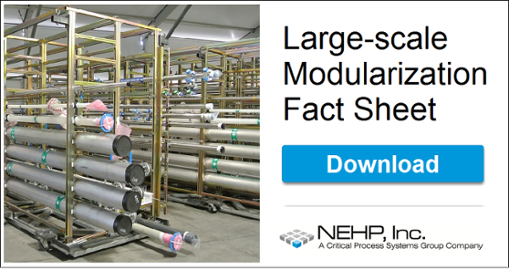/Lean%20Waste%20-%20Overproduction.png?width=238&name=Lean%20Waste%20-%20Overproduction.png) OverComing Overproduction
OverComing Overproduction
Overproduction is defined as any type of production that is more than needed or before it's needed. It can result in excess inventory and it consumes time, effort, money, materials and resources that could have otherwise been spent more effectively elsewhere.
With regard to construction productivity, modular off-site fabrication can help combat overproduction waste on large-scale process utility projects.
Causes of Overproduction
In general, overproduction often begins with lack of awareness. By getting mired in the status quo, not asking questions and not reviewing construction (or production) processes and procedures, overproduction can easily take root in any faults or gaps that are "allowed" in the planning and execution process. Such faults often include:
- The desire for longer than necessary production runs or product batch sizes due to long setup times
- Ordering more supplies than necessary, just in case
- Expecting disrupted production flows
- Unbalanced production stages, cells, or departments
- "Forecasting" what the customer might want in the future, creating a false demand
/Large-scale%20modularization.png?width=2016&name=Large-scale%20modularization.png) Modular off-site fabrication and integration programs help to eliminate construction overproduction waste on large-scale process utility projects.
Modular off-site fabrication and integration programs help to eliminate construction overproduction waste on large-scale process utility projects.
Effects of Overproduction
Overproduction can cause a draw on capital for extra materials, unnecessary tools and machinery, additional facility capacity, and excessive inventory space. This creates cash flow constraints and can impair the attention and effort needed for more productive activities.
Construction overproduction waste can create its own feedback loop. It often begins with a false demand or inaccurate calculation of what is actually required to complete the scope of work. Incomplete or inaccurate information will then drive inefficiencies throughout the entire process. Such inefficiencies might include:
- Over-staffing
- Over-supplying
- Over-shipping
- Cost and schedule overages
- Material waste, and more...
All of this can further cloud awareness and diminish reporting accuracy which can further reinforce the problem at hand.
Solutions for Overproduction
1) Thinking critically about what we do and why we do it is an important first step to combating overproduction. Creating a heightened awareness of procedures and practices can ultimately lead to:
- Improvements in employee training
- Improvements in planning and execution
- Further reduction of wasteful and unnecessary actions
- Greater familiarity with and acceptance of lean methods like Just-In-Time (JIT) delivery
2) Practicing JIT delivery and producing only what the customer demands. This can be largely achieved by:
- Running smaller batch sizes
- Creating more reliable processes, and trusting in them
- Establishing stable schedules
- Balancing departments
- Using accurate information to map actual demand
3) Collaborating and partnering with other Lean advocates. Overproduction can be greatly diminished (almost automatically) by working with individuals and organizations who are committed to similar goals and who possess the tools, skills and/or software to support Lean production models.
If you would like to learn more about useful Lean methods for construction productivity improvement, please feel free to:
Visit Our Lean Construction Integration Page Here
OR
Visit Our Large-scale Modularization Page Here
Continue to Part 3 of our 8 Wastes of Lean Construction Series, where we examine "waiting" as a primary waste contributor.
